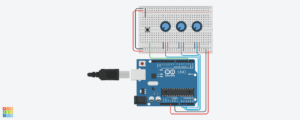Step 1:
Robert’s Project
Robert’s project is about making a battleship game which is a combination of the physical game and digital game. He wants to detect the 3D-printed battleships that are placed on a grid board and display their positions on the screen. My suggestion is that he can probably use a large amount of distance sensor to determine the positions of the physical battleships, but that need lots of I/O resource. I was impressed by his idea of using the physical object to control the virtual objects on the screen. It is like synchronizing the virtual world with the real one.
Kenneth’s Project
Kenneth wants to make a secret room game. In this game, the player needs to find out four different passwords to escape the room. His initial expectation was making a 3D game. However, I told him that it could be a huge task to create a 3D game in Processing. Therefore, he changed his idea and planned to make the game 2D. The significance of his project is that he wants to appeal to people’s concern for people with depression. I think this is a great idea.
Sheldon’s Project
Sheldon plans to make a 2-player game. One player needs to control the rubbish on the sea surface. And another player needs to try not to touch those rubbish. He proposes to arouse people’s awareness of protecting the sea and marine life. I suggested that his game doesn’t create a close relationship between two players. Thus, he probably needs to redesign the players’ tasks.
What I Found
By listening to my peers’ introduction to their projects, I found a similarity–they all plan to make a game. I entirely agree that a game could be an ideal form that perfectly fits most of our definitions of interaction. A game usually requires continuous input and gives continuous output. The input and output are mutually connected. More importantly, a game is always meaningful, as it makes people happy.
Step 2
For my project, I received lots of valuable suggestions from my group. One tip is that I should add more Arduino-based interaction. For instance, I can use the Arduino to receive input data from potentiometers and buttons. Another suggestion is about the significance of my project. I said that my project would help people meditate and relax. But I still need to find more reliable resources online to support my argument and prove the effectiveness of my project.
